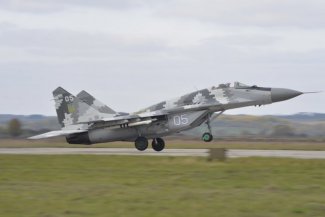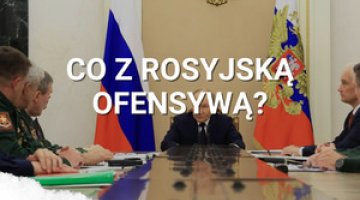Air crash in Zhytomyr oblast. Day 551 of the war

On 25 August, an air crash occurred in Zhytomyr oblast. According to initial reports, two MiG-29 fighter jets collided. The Ukrainian Air Force Command referred to the incident the following day, stating that “the crews of two L-39 trainer-combat aircraft collided in the sky while performing a combat mission”. On 27 August, the 40th Tactical Aviation Brigade (TAB), based at Vasylkiv airfield in Kyiv oblast, reported that three experienced pilots had died in the crash: the brigade’s deputy commander Major Serhiy Prokazin, Major Vyacheslav Minka (a retired pilot who had returned to active duty in 2015) and fighter ace Captain Andriy Pilshchykov, callsign ‘Juice’. All were posthumously promoted to higher military ranks. Pilshchykov, who had flown more than 500 hours in combat as of February 2022, was a frequent figure in Western media, where he called for the transfer of F-16 fighters to Ukraine. During the first weeks of the Russian invasion, the main burden of Kyiv’s air defence fell on the MiG-29 fighter pilots of the 40th TAB, who became known collectively as the ‘Spirit of Kyiv’.
Ukrainian forces are continuing their attempts to break through Russian lines south of Orikhiv. Contrary to earlier reports from Kyiv that the village of Robotyne had been retaken (which deputy defence minister Hanna Maliar repeated on 28 August), fighting over the area is still taking place. According to reports from some frontline correspondents, as a result of the Russian counterattacks, the central part of the village, now completely destroyed, is now no-man’s-land. This means that the Ukrainian defence ministry’s announcements that their forces have advanced further southwards towards Novoprokopivka and Ocheretuvate (the latter of which is located 10 km from the combat area) cannot be confirmed. However, the Ukrainians have expanded the area they control between Robotyne and the village of Verbove which lies east of it, and are approaching the latter village.
The Russians have not made any significant new advances south-east of Kupyansk. On 25 August, the commander of the Ukrainian Land Forces, General Oleksandr Syrskyi, described the situation on the Kupyansk and Lyman axes as tense. At the same time, he noted that after a month of fierce fighting and heavy losses, the enemy is regrouping its forces while sending newly formed divisions and brigades into action from Russian territory. Kyiv estimates the size of Russian forces on the Kupyansk axis at 45,000, and 48,000 troops on the Lyman axis. Including support facilities, the invaders are estimated to have 110,000 troops at their disposal.
The intensity of both sides’ operations on the other flanks has fallen off. On 28 August, Ukrainian deputy minister Maliar reported that defenders had liberated 1 km² of territoryon Bakhmut’s southern flank during the week, bringing the area retaken in that region up to 44 km². According to reports from the Ukrainian General Staff, the only place where the Russians have made continuous attempts to break through Ukrainian defences is Marinka. Their attacks in the areas of Avdiivka, Bakhmut, south of Kreminna and on the border of Luhansk and Kharkiv oblasts have slowed down since 27 August, and have been limited to shelling and bombardment.
On 26 August, the Guardian newspaper reported that a meeting had taken place 11 days earlier on the Polish-Ukrainian border between General Valerii Zaluzhnyi, the Commander-in-Chief of the Ukrainian army; General Christopher Cavoli, the commander of US forces in Europe, who is also the supreme commander of NATO allied forces in Europe; and Admiral Tony Radakin, the Chief of the UK Defence Staff. The conversation focused on tackling the halting progress of the Ukrainian offensive, the plans for combat operations over the upcoming ‘gruelling’ winter, and long-term strategy in view of the ‘inevitable’ extension of the war into 2024. The allies suggested that the Ukrainian Armed Forces should not disperse their efforts around several fronts, but should rather focus on a single direction to break through Russian defences (General Mark Milley, head of the College of the Joint Chiefs of Staff, also made similar recommendations to Zaluzhnyi during their teleconference on 10 August). The Guardian’s interviewees believe that the Ukrainians’ strategy has changed as a result of the talks, and they are now focusing on the Zaporizhzhia front; the aim here is to reach the key junction at Tokmak, which would be the first step towards reaching the Sea of Azov, and consequently cutting Russia’s land bridge to Crimea.
On 28 August, Russian rockets attacked Hoholeve in Poltava oblast, destroying industrial installations. Three workers were reportedly killed and five injured. The region of Kryvyi Rih was also targeted in the attacks; its defenders claimed that shrapnel from the downed rockets caused the damage. Druzhkivka in Donetsk oblast was also struck. According to the Ukrainian General Staff, the Russians used a total of eight missiles that day, with the Air Force Command declaring that two of the four Kalibr missiles the Russians used had been shot down, as well as both of the Kh-59 missiles. On 27 August, Russian missiles struck an airfield near the village of Pinchuky south-west of Kyiv, as well as other targets in Kropyvnytskyi and Cherkasy oblasts. In total, the invaders used 11 missiles that day, while the defenders claimed to have shot down four of the eight Kh-101/Kh-55/Kh-555 cruise missiles. On 26 August, Kramatorsk oblast and the village of Bahatyr in the western part of Donetsk oblast were targeted by Russian missile attacks (in total, five missiles were used).
On 25 August, the Security Service of Ukraine (SBU) reported that on the previous night a special operation had been carried out in conjunction with the Ukrainian army against the base of the Russian 126th Mechanised Brigade (which Russian nomenclature refers to as a coastal defence brigade) in Perevalne, Crimea. The kamikaze drone attack allegedly killed and wounded dozens of Russians, hit an ammunition storage site and severely damaged the equipment there. Two days later, the SBU reported that the operation had been codenamed ‘Top Gun’. On that same day, the SBU reported that it had carried out a similar attack on a military airfield near Kursk, hitting four Su-30 multi-role combat aircraft, a MiG-29 fighter, an S-300 air defence system radar and two Pantsyr self-propelled anti-aircraft systems. The SBU’s reports of the attacks’ impact have not so far been confirmed by other sources or material from satellite imagery. According to the Russian defence ministry, the Ukrainians unsuccessfully continued drone attacks on Crimea (also using a Neptun missile) and on the Bryansk, Kursk, Tula and Moscow oblasts (another drone was shot down over Moscow on 26 August). A warehouse fire in the Kozacha Bukhta area of Sevastopol on 26 August was probably the result of a Ukrainian attack.
On 25 August, the Ukrainska Bronetekhnika company announced the delivery to the Ukrainian Armed Forces of the first thousand 122-mm calibre fragmentation and demolition shells (for the D-30 towed howitzer and the 2S1 Gvozdika self-propelled howitzer), which were produced “in partnership with an Eastern European ammunition holding company”. In the following days, President Volodymyr Zelensky and defence minister Oleksiy Reznikov reported on the development of arms and ammunition production. The Ukrainian president mentioned Neptun anti-ship cruise missiles, as well as RK-3 Korsars and Skif/Stuhna-P anti-tank guided missiles (in July it was reported that the latter will be produced in cooperation with companies outside Ukraine). He also mentioned plans to produce 155-mm artillery ammunition, and the possible launch of a ‘covert factory’ for Swedish CV90 infantry fighting vehicles inside Ukraine. Zelensky noted that negotiations with partners on the joint production of this type of IFV are still ongoing; Kyiv is expecting to collaborate on this with Prague and Bratislava, whose armies also use CV90s.
On 25 August, Latvian’s defence minister Ināra Mūrniece announced her country was transferring another Mi-17 helicopter to Ukraine, the third of four which have been declared. On the same day, the Greek media reported that Athens had decided to cancel the contract for Russia to service the Tor-M1 (21 units) and Osa-AKM (38 units) anti-aircraft systems. They may be withdrawn from the Greek army’s arsenal in the near future, as the stock of spare parts is sufficient for just a few more months; they may then be transferred to Ukraine via third countries. On 28 August, the Greek media reported that Berlin had offered Athens 100 used Leopard 1A5 tanks to Kyiv in exchange for an equivalent number of modernised Leopard 1A5s from the Italian army’s inventory; these tanks cannot be shipped to Ukraine directly because they are currently owned by a Swiss company. Germany has offered to cover the costs of refurbishing the tanks for Greece and installing the thermal imaging cameras used in Leopard 2 tanks in them, on condition that the vehicles transferred to Ukraine must be in working order (the Greek Leopards have not undergone any major overhaul for more than thirty years).
On 28 August the Financial Times quoted Brigadier General Martin Bonn, the deputy head of the EU’s international training mission (which includes servicemen from Germany, Denmark and the Netherlands), as saying that the biggest problem in training Ukrainian soldiers is the lack of qualified translators familiar with military terminology. By the end of the year, 10,000 Ukrainian soldiers will have been trained in Germany in connection with the programme to equip the Ukrainian armed forces with tanks, artillery and air defence systems.
On 28 August a British military intelligence reported that it was possible that Russia might abandon the Zapad 2023 exercises scheduled for September in Belarus due to a shortage of troops and equipment. The Russian defence minister announced the announced exercises back in December 2022, but no preparations have been observed since then. The Belarusian-Russian Union Shield 2023 exercises announced for 23–26 September in Russia are also in doubt; the Belarusian defence ministry has not announced any plans to hold them since March this year. On 29 August, the commander of the Combined Armed Forces of Ukraine, Serhiy Nayev, announced that the Russian land component “in full composition” had been withdrawn from Belarus and was entering the reserve of the combined Russian army group which is “leading the assault” towards Kupyansk and Lyman. According to independent Belarusian observers monitoring troop movements in Belarus, around 2000 Russian troops currently remain there.
In recent days, Ukrainian media have uncovered two corruption scandals at the Ministry of Defence. One is related to deliveries from Turkey at inflated prices of summer jackets instead of winter jackets; the other is related to the failure of a Polish intermediary to complete the entire supply of artillery ammunition. On 27 August, President Zelensky announced an intensification of the fight against corruption. To this end, he intends to send a bill to parliament which will equate criminal responsibility for this type of crime with high treason during martial law (12 to 15 years’ imprisonment, confiscation of property, no possibility of parole or early release). A day later defence minister Reznikov, responding to a question from journalists on whether the President had suggested he resign, gave an evasive answer.
Commentary
- The deaths of three experienced military pilots, including one of the last representatives of the ace group known as the ‘Spirit of Kyiv’ (the first pilot given this nickname, Major Stepan Tarabalka, was shot down in April 2022; in June 2022, the group’s commander Colonel Mykhailo Matyushenko, callsign ‘Did’, or Grandfather, was killed), has drawn attention to the Ukrainian Air Force’s problem that it is running out of experienced pilots. Paradoxically, Western countries are now able to send Ukraine more aircraft (more than 100 F-16s and F-18s have been withdrawn or taken out of service in US-allied countries, not including US assets) than it has the capacity to use.
- The need for fluency in professional English is also a problem: so far only eight pilots have met the criterion (six have already embarked on training, the first part of which involves further language training), and according to British reports, there are around 20 pilots left in Ukrainian military aviation who have slightly lesser qualifications. It cannot be ruled out that the handover of the aircraft to Kyiv in 2024 (according to Reznikov, the first Ukrainian unit with F-16 fighters is expected to be ready for combat next spring), will involve pilots from the West who have retired or are on leave taking up service in the Ukrainian army; indeed, in the case of ground handling technicians, this will be unavoidable.
- The Ukrainian president’s announcement that the fight against corruption is being stepped up represents an acknowledgement that the state’s control over the use of funds is insufficient, and that the institutions responsible for combating corruption are still not functioning effectively. The proposed introduction of harsher penalties should serve as a deterrent and stigmatise those guilty of corruption. The latest scandals related to the purchase of equipment for the army may hasten Reznikov’s resignation. For several weeks, the names of potential successors have been circulating in the media, including deputy prime minister Oleksandr Kubrakov and minister for strategic industries Oleksandr Kamyshin. Reznikov’s dismissal was first rumoured at the beginning of the year, following the discovery of irregularities in military procurement (for more, see ‘Ukraine: a wave of dismissals against a background of corruption’).




